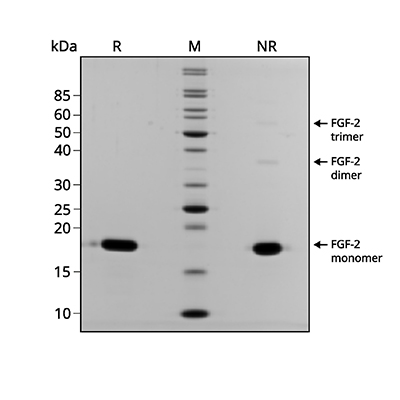 Recombinant eel FGF-2 (154 aa) protein (Qk107)
Recombinant eel FGF-2 (154 aa) protein (Qk107)Recombinant eel FGF-2 (154 aa) protein (Qk107)
£120.00 – £670.00

Recombinant eel FGF-2 protein 154 aa (bFGF/basic FGF) for the development of optimized serum-free culture media for species-specific European (Anguilla anguilla), Japanese (Anguilla japonica) and American (Anguilla rostrata) eel in cellular agriculture protocols and veterinary research applications. This longer form of FGF-2 is used in comparative cell culture media optimization studies alongside Qk106, the 145 aa form of eel FGF-2. FGF-2 is used extensively in the maintenance and proliferation of induced pluripotent (iPSC) and embryonic stem cells (ESC) and for enhancement of proliferation in primary eel cell culture. Receptor binding affinity and efficacy may differ depending on each species. Using a species-specific growth factor enhances receptor binding affinity, resulting in a lower concentration required in culture.
Eel FGF-2 is a high purity 17.2 kDa FGF-2 / bFGF protein, animal origin-free (AOF) and carrier-protein free (CF).
In stock
Orders are typically shipped same or next day (except Friday).
Easy world-wide ordering, direct or through our distributors.
£120.00 – £670.00
1000µg will be despatched as 2 x 500µg
Fast and free shipping.
Buy online with secure credit card or purchase order. For any questions, please email orders@qkine.com
Summary:
- High purity protein specific to European (XP_035281190.1), Japanese, and American (XP_064200074) eel
- 17.3 kDa (monomer)
>98%, by SDS-PAGE quantitative densitometry
Expressed in E. coli
Animal origin-free (AOF) and carrier protein-free
Manufactured in our Cambridge, UK laboratories
Lyophilized from Tris, NaCl, CyS, mannitol
- Resuspend in sterile-filtered water at >50 µg/ml, add carrier protein if desired, prepare single use aliquots and store frozen at -20 °C (short-term) or -80 °C (long-term).
Featured applications:
Expansion of eel pluripotent, embryonic and mesenchymal stem cells
Serum-free media development
Cellular agriculture and cultivated meat cell culture media optimization
Cellular proliferation, migration and survival

Recombinant eel FGF-2 154 aa activity was determined using the Promega serum response element luciferase reporter assay (*) in transfected HEK293T cells. Cells were treated in triplicate with a serial dilution of FGF-2 for 3 hours. Firefly luciferase activity was measured and normalized to the control Renilla luciferase activity. Data from Qk107 lot 204654. EC50 = 0.127 ng/ml (7.5 pM) *Promega pGL4.33[luc2P/SRE/Hygro] #E1340
Recombinant Eel FGF-2 154 aa migrates as a major band at approximately 17 kDa (monomer) in reduced (R) and non-reduced (NR) conditions. The dimeric and trimeric forms are also observed at approximately 34 and 51 kDa, respectively. No contaminating protein bands are present. The purified recombinant protein (3 µg) was resolved using 15% w/v SDS-PAGE in reduced (+β-mercaptoethanol, R) and non-reduced (NR) conditions and stained with Coomassie Brilliant Blue R250. Data from Qk107 lot #204654.

Further quality assays
Mass spectrometry: single species with expected mass
Recovery from stock vial: >95%
Endotoxin: <0.005 EU/μg protein (below level of detection)
We are a company founded and run by scientists to provide a service and support innovation in stem cell biology and regenerative medicine. All our products are exceptionally high purity, with complete characterisation and bioactivity analysis on every lot.

Recombinant eel FGF-2 154 aa activity was equivalent to human FGF-2 154 aa (Qk027). Bioactivity was determined using the Promega serum response element luciferase reporter assay (*) in transfected HEK293T cells. Cells were treated in triplicate with a serial dilution of FGF-2 for 3 hours. Firefly luciferase activity was measured and normalized to the control Renilla luciferase activity.
Protein background
Fibroblast Growth Factor 2 (FGF-2), also known as basic fibroblast growth factor (bFGF), is a key member of the fibroblast growth factor family, playing pivotal roles in various cellular processes such as growth, differentiation, and angiogenesis [1-3]. FGF-2 is a significant growth factor in embryonic development, tissue repair and wound healing. FGF-2 (154 aa) consists of 154 amino acids and exhibits a molecular weight of around 17.2 kDa. It comprises multiple isoforms and is characterized by a β-trefoil fold, stabilized by disulfide bonds, essential for biological activity.
FGF-2 plays a crucial role in stem cell research development by serving as a key component in maintaining the pluripotency and self-renewal of embryonic stem cells (ESCs) and induced pluripotent stem cells (iPSCs) [2]. FGF-2 is commonly used as a growth factor in cell culture media to maintain the pluripotent state of ESCs and iPSCs. It activates signaling pathways, including the mitogen-activated protein kinase (MAPK) pathway, which helps to sustain the expression of pluripotency-associated genes such as Oct4, Sox2, and Nanog. This prevents the differentiation of stem cells and allows for their expansion in vitro [2].
FGF-2 can be incorporated into scaffolds or hydrogels along with stem cells to promote their proliferation and differentiation within a three-dimensional environment. This holds great promise for the development of cultivated eel protocols and serum-free media development in the cellular agriculture industry [4].
Additional resources
FAQ
Fibroblast growth factor 2 (FGF-2), also known as basic fibroblast growth factor (bFGF) is a growth factor and signaling protein.
FGF-2 is expressed in a developmental and tissue specific manner. It’s expression is tightly controlled in normal tissues and it can be detected in all major tissues.
FGF-2 is essential for normal embryonic development. It has roles in cell survival and proliferation, angiogenesis, tumorigenesis, wound healing and tissue repair.
FGF-2 binds to and signals though all four of the FGF receptors FGFR1-4.
FGFRs phosphorylate specific tyrosine residues and activate the RAS-MAPK, PI3K-AKT, PLCγ, and STAT intracellular signaling pathways.
FGF-2 is used to maintain the pluripotency of stem cells in culture.
Our products are for research use only and not for diagnostic or therapeutic use. Products are not for resale.

Receive an Amazon gift voucher when you leave us a review.
£25, $30 or €30 for reviews with an image and £10, $15 or €15 for reviews without an image